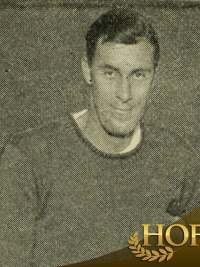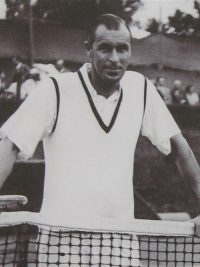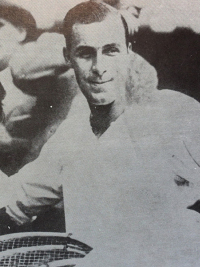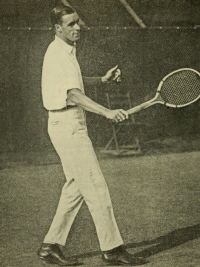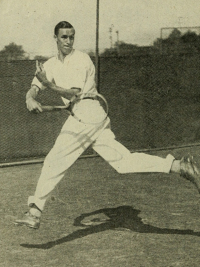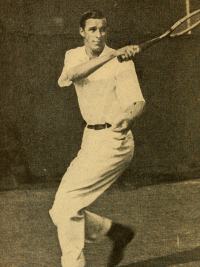William Tilden II
Full name: William Tatem Tilden II
Nickname: Big Bill
Nickname: Big Bill
| Born |
Subscribe now
This information and data is not available because you are not our subscriber yet.
Please click here and get full access to the entire database! |
|---|---|
| Died | |
| Class of HOF | |
| Height | |
| Weight | |
| Plays | |
| Bio | William Tatem Tilden II nicknamed "Big Bill," was an American male tennis player. He is often considered one of the greatest tennis players of all time. Tilden was the World No. 1 player for seven years. He won 14 Major singles titles including 10 Grand Slams, 1 World Hard Court Championships and 3 Pro Slams. He also won a record seven US Championships titles (shared with Richard Sears and Bill Larned). He dominated the world of international tennis in the first half of the 1920s, and during his 18-year amateur period of 1912–30, he won 138 of 192 tournaments. He owns a number of all-time tennis achievements including a career match winning record of 93.60% 907/62. His career winning percentage at the US National Championships was 90.69% 69/7 that ranks him first ahead of Roger Federer, Fred Perry and Pete Sampras, and also a 42 match win streak from 1920 to 1926 is ahead of Roger Federer and Ivan Lendl. His 95 match winning streak from 1924 to 1925 is ahead of Don Budge and Roy Emerson, and also his best win-loss single season coming in 1920 at 98.73%, 78/1, places him ahead of John McEnroe and Jimmy Connors. In addition he remains the only player to reach 10 Major finals at a single Grand Slam event in a career at the US National Championships. At the Wimbledon Championships, he recorded a career 91.18% 31/3 match record ranking him 3rd all-time behind Björn Borg and Don Budge. Tilden was born into a wealthy Philadelphia family bereaved by the death of three older siblings. His father was William Tatem Tilden, a wool merchant and local politician, and his mother Selina Hey was a pianist. He lost his semi-invalid mother when he was 18 and, even though his father was still alive and maintained a large house staffed with servants, was sent a few houses away to live with a maiden aunt. The loss at 22 of his father and older brother Herbert marked him deeply. After several months of deep depression, and with encouragement from his aunt, tennis, which he had taken up starting at age five, became his primary means of recovery. According to his biographer, Frank Deford, because of his early family losses Tilden spent all of his adult life attempting to create a father-son relationship with a long succession of ball boys and youthful tennis protégés, of whom Vinnie Richards was the most noted. In spite of his worldwide travels, Tilden lived at his aunt's house until 1941 when he was 48 years old. Tilden attended the University of Pennsylvania and graduated from Peirce College. Tilden went to the prep school Germantown Academy where he wasn't known for his tennis nor was he good enough to play on his college team. The shy, self-absorbed, sometimes arrogant young man dropped out of the University of Pennsylvania and in 1900 began to practice his game against a backboard, and he also became a dedicated student of the game. The following year he won his first tournaments; the junior singles and doubles title of Germantown. In just three years, he worked his way up the ranks. His first national title was winning the mixed doubles championships with Mary Browne in 1913 and they successfully defended the title in 1914. From 1914 to 1917 he won the Philadelphia championship. Prior to 1920, he had won a number of Canadian doubles titles[citation needed], but at the U.S. National Championships in 1918 and 1919 he lost the singles final to Robert Lindley Murray and "Little Bill" Johnston, respectively in straight sets. He won six consecutive U.S. singles championships from 1920–1925 and seven in total, making him the co-record holder with Richard Sears and Bill Larned. In the winter of 1919–20, he moved to Rhode Island where, on an indoor court, he devoted himself to remodeling his relatively ineffective backhand into a much more effective one. With this change, he became the world no. 1 tennis player and the first male American to win the Wimbledon singles championship. In the mid 1920s Tilden came into conflict with the USLTA regarding alleged violations of the amateur rule, specifically relating to the monetary compensation he received for writing tennis articles. In the late 1920s, the great French players known as the "Four Musketeers" finally wrested the Davis Cup away from Tilden and the United States, as well as his domination of the singles titles at Wimbledon and Forest Hills. Tilden had long been at odds with the draconically rigid amateur directors of the United States Lawn Tennis Association about his income derived from newspaper articles about tennis. He won his last major championship at Wimbledon in 1930 at the age of 37, but was no longer able to win titles at will. In 1931, in need of money, he turned professional and joined the fledgling pro tour, which had begun only in 1927. For the next 15 years, he and a handful of other professionals such as Hans Nüsslein and Karel Koželuh barnstormed across the United States and Europe in a series of one-night stands, with Tilden still the player that people primarily paid to see. Even with greats such as Ellsworth Vines, Fred Perry, and Don Budge as his opponents, all of them current or recent world no. 1 players, it was often Tilden who ensured the box-office receipts—and who could still hold his own against the much younger players for a first set or even an occasional match. Tilden thought he reached the apogee of his whole career in 1934 at 41 years old; nevertheless, that year he was dominated in the pro ranks by Ellsworth Vines. The players faced each other at least 60 times in 1934, Tilden winning about 19 matches and Vines 41. American Lawn Tennis reported that on May 17, at tour’s end, Vines led Tilden by 19 matches for the year (slightly over about 50 matches would have been played) so a possible win-loss record on May 17 was 16–35; both players then met at least 6 times during the rest of the year (Ray Bowers has listed 5 tournament matches and 1 one-night program), all lost by Tilden. Then both players met at least six times (five times in tournaments and once in one-night indoor program), with Tilden losing all his matches. In 1945, the 52-year old Tilden and his long-time doubles partner Vinnie Richards won the professional doubles championship—they had won the United States amateur title 27 years earlier in 1918. Tilden coached Germany's tennis team in the 1937 Davis Cup. In the inter-zone finals, the U.S. team won after the deciding singles clash between Gottfried von Cramm and Don Budge, a match which has been called "The Greatest Tennis Match Ever Played". Although Tilden had been born to wealth, and earned large sums of money during his long career, particularly in his early years on the pro tour, he spent it lavishly, keeping a suite at the Algonquin Hotel in New York City. Much of his income went towards financing Broadway shows that he wrote, produced, and starred in. The last part of his life was spent quietly and away from his family, occasionally participating in celebrity tennis matches. He died in his apartment at 2025 North Argyle in Los Angeles, California. He was preparing to leave for the United States Professional Championship tournament in Cleveland, Ohio, in 1953 when he fell dead of a stroke. Tilden is buried in Ivy Hill Cemetery in Philadelphia. Tilden was inducted into the International Tennis Hall of Fame in Newport, Rhode Island, in 1959. source:wiki |
| Misc | Subscribe now |
| Tournament | AO | RG | W | US | Win-Loss |
|---|---|---|---|---|---|
|
Subscribe now
This information and data is not available because you are not our subscriber yet.
Please click here and get full access to the entire database! |
|||||
